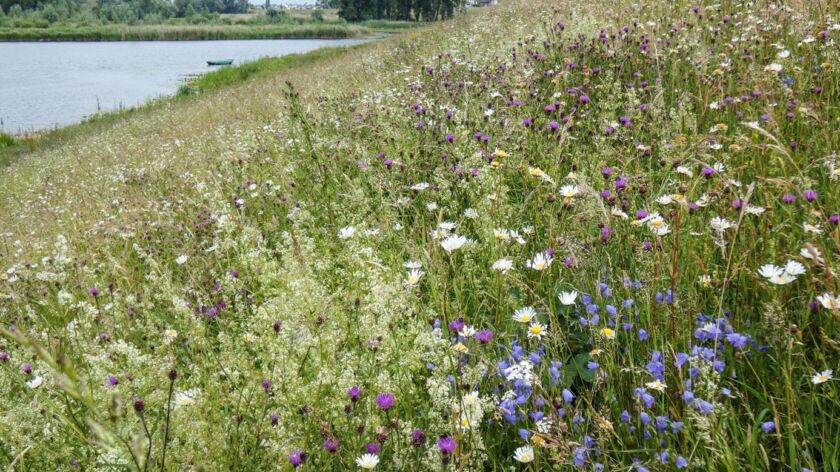Embankments filled with flowers just as strong as grassy dikes, good news for biodiversity
-
 Beeld: Radboud Universiteit
Beeld: Radboud Universiteit
According to research by the Future Dikes programme, dikes filled with flowers instead of grass are just as strong. That is good news, as embankments with a variety of grasses and herbs look more colourful. Not only that, but they can contribute to restoring biodiversity in our country.
The Netherlands have roughly 17,000 kilometres worth of dikes, most of which is covered solely with grass. Only three to five percent of all embankments have a mixture of various grasses and herbs, the so-called floral dikes. These embankments are an oasis of special flowers, plants and species of insects in the summertime. They make for a nice view, but are they as sturdy as ordinary green grass dikes?
That was the research goal of Radboud scientists with the Future Dikes programme, which for the last few years has compared the turf of floral dikes with that of the more traditional grass dikes. Among other things, the researchers investigated differences in vegetation, soil, and erosion sensitivity. Using massive machinery, they tested the strength of the Maasdijk near Wijchen; every few minutes, they tossed a huge wave across the dike, to see if the structure would hold or fold
Additionally, to find out which plants offer the best results, the scientists have been building miniature dikes on the Nijmegen campus, behind the Huygens building. They have been experimenting with different seed mixtures.
Connecting factor
The first research phase is now complete. Various tests have shown that the more diverse dikes are at least as strong and secure as the conventional grass ones. Not only that, but they have much greater biodiversity. ‘Our research shows that floral dikes are virtually as strong as grass dikes’, according to professor of plant ecology Hans de Kroon. ‘Traditional grass dikes owe their strength mainly to the soil, which is heavy clay.’ Floral dikes have a much lighter soil, but they make up for the difference with stronger root growth.’
‘These embankments contribute to the biodiversity of the river landscape’
As stated by De Kroon, this makes little difference for chances of flooding: ‘Floral dikes are just as secure. We have every reason to place them wherever possible; a more diverse coverage also attracts more species of insects. That means that the embankment contributes to the biodiversity of the river landscape.’ And because the dikes can be found all over the Dutch landscape, De Kroon thinks that they can be a connecting factor between various ecosystems.
Development of floral dikes
Over the next thirty years, those 1,500 kilometres of dikes will need to be strengthened to live up to security standards. The research team hopes that the Dutch dikes of the future are more floral than the current ones. That is why they set up a guideline, with recommendations for the construction and development of floral dikes. The researchers offer advice on various topics, ranging from soil composition, to maintenance, and even the right seed mixtures.
During a symposium, to be held today, the project team will share their insights. They will also look ahead to phase two of the Future Dikes project.
Translated by Jasper Pesch



